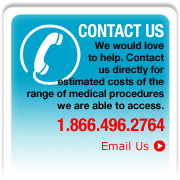
|
|
AngioplastyEvery year, thousands of clients, (many of them uninsured, underinsured, or self insured), turn to the North American Surgery Inc group, to have their surgeries expedited quickly, at significant savings, close to home. No longer is there any need to travel great distances for uninsured medical procedures, such as angioplasty surgery. If you need angioplasty surgery, but you are uninsured, North American Surgery can help you. What is an angioplasty?Following a diagnostic angiogram , your doctor may determine you would benefit from an angioplasty. In the Angioplasty procedure, the physician threads a thin plastic tube topped by a very small balloon into your heart artery that has been narrowed or blocked by coronary artery disease. Coronary artery disease occurs when the blood vessels that supply your heart becomes narrowed or blocked by fatty deposits known as plaque. This plaque narrows the arteries β and sometimes even blocks them β making it difficult for the blood to get through. And without a continual supply of fresh, oxygen-rich blood, your heart cannot do its job. The angioplasty balloon, when it is inflated, will clear small blockages. The doctor then deflates the balloon and removes it. Sometimes, however, this is not enough to keep the artery open, and, in those cases, the doctor will insert a vascular stent. This is a small wire mesh tube that is left in the artery permanently. The stent may also be coated with drugs that are aimed at preventing further narrowing. Why do I need an angioplasty?You may be a good candidate for angioplasty if:
Angioplasty is a minimally invasive procedure that does not require a general anesthetic and has an excellent record of success in appropriate cases. Prior to angioplasty, you will require an angiogram to determine the nature and extent of the blockages in your coronary arteries. Short blockages that are close to the beginning of the artery respond best to angioplasty. Longer, more complicated blockages, however, may require coronary bypass surgery. What will happen during an angioplasty?An angioplasty is not surgery β instead, it is a procedure. You may be given medicine to relax you, but you will stay awake throughout. The doctor will numb the spot in your arm or leg where the catheter is to be inserted. You may feel a dull pressure where the doctor is working, but no pain. Once the balloon reaches the blockage, the balloon will be inflated for several seconds. This may happen several times in the same place, or the doctor may select several different places. Itβs common for patients to feel mild discomfort during the inflation because the artery is being stretched. If a stent (a tiny mesh tube that looks like a small spring) is being used, the doctor will remove the first catheter and insert new one with a closed stent surrounding a deflated balloon. He or she will position it where the artery was previously widened and inflate the balloon, expanding the stent. The doctor then deflates and removes the balloon, leaving the stent behind. The entire angioplasty procedure may be as brief as 30 minutes or may take up to two hours, depending on the complexity of your case. What are the possible complications of an angioplasty?Perhaps the biggest risk is that your artery will again become blocked at the site where the balloon was inflated. This can happen soon after the procedure or years later. Blood clotting problems, kidney problems and age can increase your risk for complications. Allergies can increase your risk of a reaction to the dye. When the procedure is complete you may experience some bleeding, pain, bruising or swelling where the catheter was inserted. Blockages can develop in the arteries downstream from the plaque if plaque particles break free during the angioplasty. Rarely, impaired kidney function or kidney failure can occur following an angioplasty, especially if you already have kidney disease. Rarely, a heart attack can occur during or shortly after the procedure. The doctor who will be performing the procedure will help you assess your risks and discuss how to minimize them. What happens after the procedure?You may be required to stay in bed for up to 24 hours after your angioplasty. After you return home, you will likely be given instructions to limit your activities, not lift anything heavy for several weeks and to drink plenty of water to flush the dye out of your system. You may be prescribed aspirin or other drugs to thin your blood. In an appointment following the procedure, your doctor will likely perform tests to see how the blood is flowing through your treated artery. What to do if you are Uninsured, Under-Insured or Self-InsuredNorth American Surgery Inc. acts as a facilitator, bringing our clients together with private medical clinics and hospitals that can provide the needed services and/or procedures in a timely manner and at affordable prices to the uninsured. If you are uninsured and want more information about private medical care, contact North American Surgery Inc. today. |




|
SITEMAP | Copyright 2025 North American Surgery |
About UsFor the last four years we have been facilitating surgical procedures for clients wishing to access the favorable pricing which we have negotiated with hospitals and clinics across the country. |
ServicesNorth American Surgery Inc. is able to access reasonably priced surgical procedures of all types in U.S. based facilities. Our clients pay a small fraction of the standard prices charged by most U.S. hospitals. Typically the prices we have negotiated are comparable to the costs associated with off-shore surgery in places such as India, Thailand or Mexico. |
ProcedureThe role of our firm is to act as a facilitator, brining our clients together with private medical services and clinics which can provide the needed services and / or procedures in a timely manner. Once arrangements have been made to the mutual satisfaction of our client and their physician, we have no ongoing involvement in the doctor-patient relationship. |
NEWSFAQsTestimonialsLinks |